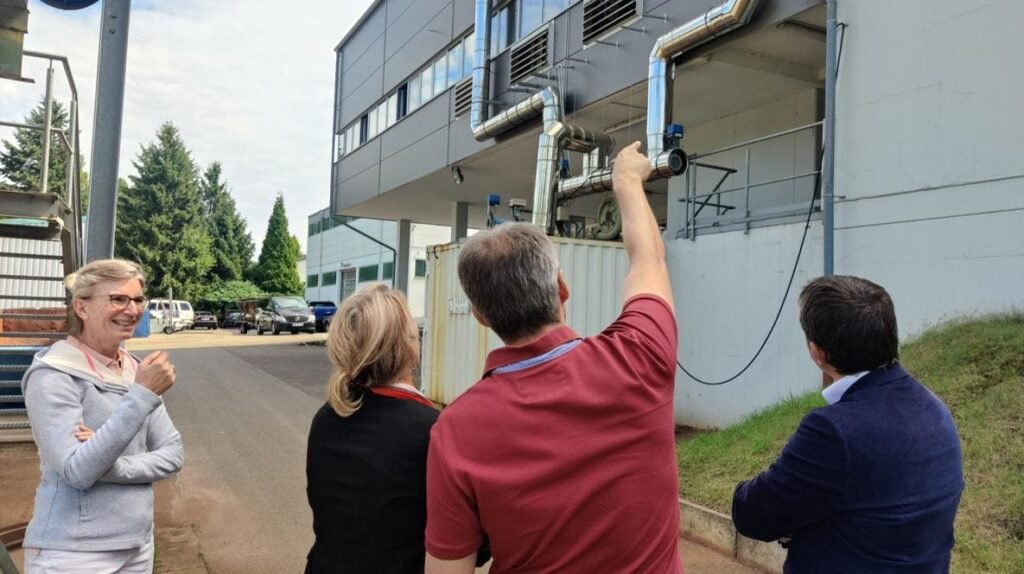The Kraftblock team at the site of one of their firm’s thermal batteries, installed at a ceramics plant. The battery is the white container connected to the building via the chrome pipes.
Kraftblock
About half of all global energy use is for generating heat; this proportion rises to between two-thirds and 70% in the industrial sector. Industrial firms seeking to switch to renewables to electrify operations must find efficient storage mechanisms that eliminate intermittency issues. Some entrepreneurs are looking beyond chemical batteries to store thermal energy directly—a new field called thermal energy storage.
TES systems have substantial advantages over chemical batteries: The raw materials used to store energy—dirt, concrete, salt—are cheap and plentiful. Thermal batteries tend to have very long lifespans—measured in decades rather than years. Also, converting power to heat, or simply storing heat to be used later, is very efficient—in the 95% range.
There are three approaches to TES: sensible, latent, and chemical systems.
Sensible Thermal Energy Storage
You engage in sensible heat storage every morning in your coffee thermos: fill an insulated container with a hot liquid to be enjoyed later. This is, by far, the most common TES approach in industry, with most companies using legacy technologies like refractory bricks and molten salt to store heat in insulated shipping containers.
American start-up Rondo, co-founded by the founder of a company I covered in this column, GlassPoint Solar (RIP), has announced projects totaling over 200MWh of energy storage and 3GWh of total partnerships. Rondo uses the legacy technology of refractory bricks to store energy at temperatures up to 1,500°C and offers two standard battery configurations—one with 100MWh of capacity, the other with 300MWh.
Kraftblock, a German startup founded in 2014 by chemist Martin Schichtel and economist Susanne König, has developed a proprietary storage medium comprised of recycled steel slag—a waste product from blast furnaces—and a phosphate binder. This storage medium has a very high energy density, allowing its batteries to be transported from a charging facility (e.g., a biofuel power plant) to a discharging facility (e.g., water boilers in an apartment block) and at high temperatures–up to 1,300°C. The company is just completing the largest thermal battery in Europe, which will supply heat to a PepsiCo snack food manufacturing facility in the Netherlands. Kraftblock’s battery replaces a 25MW natural gas boiler and will be charged by grid-supplied renewable energy when grid use is low.
Latent and Thermochemical Energy Storage
Latent storage systems store energy when a substance is in one state and releases energy when the substance changes into another state. The most familiar example of latent heat devices are rechargeable hand warmers, which contain a super-concentrated solution of sodium acetate in water. When the hand warmer is activated, the liquid crystallizes, releasing heat; it is recharged by boiling it in water.
A disadvantage of latent heat systems is that most materials used in this application release only low-intensity heat. One company, a U.K.-based firm called Sunamp, uses a modified version of the sodium acetate trihydrate solution found in hand warmers. Sunamp’s focus is wholly on residential use in water heaters and the like with maximum storage temperatures of around 130°C.
MGA Thermal, an Australian startup, is developing another example of a latent heat system for industrial use, a hybrid system in which metal alloy “chips” are suspended in a graphite block “cookie”. The alloy undergoes a phase change from solid to liquid upon charging, then releases heat as it cools and solidifies. The chips release latent heat, while the graphite blocks release sensible heat. The graphite blocks fully encapsulate the chips to prevent the liquid metal from leaking when the systems reach a maximum temperature of around 700°C.
Chemical storage methods use energy to break chemical bonds to form two chemicals. An example reaction is slaked lime transforming into quicklime and steam when heated to around 500°C. The resultant chemicals can be stored separately then combined later to release some of the heat that was used to trigger the initial reaction. The chemicals in these reactions have very high energy densities and are easily transported; however, chemical engineering challenges have prevented this form of storage from being used outside the laboratory.
The Climate Impact of Thermal Energy Storage
According to a 2021 IEA report, industrial heat alone emits approximately 9.4 Gt CO₂ per year, equivalent to around one-fifth of global CO₂ emissions. Although some of this heat cannot be efficiently generated and stored through renewable energy and TES batteries, we don’t see why a significant proportion of this carbon footprint could not be eliminated (CCS and/or hydrogen technology will have to be improved to address the remainder).
While thermal energy storage is still a nascent technology, we consider it essential and expect it to grow in importance as we move deeper into the post-Climate age. Intelligent investors take note.


